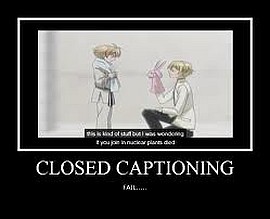Summary of On television, how does closed captioning work?
This article explains closed captioning, a feature that benefits hearing-impaired viewers, people in noisy places, and language learners by displaying text of spoken dialogue on screen. Captions are encoded in line 21 of the TV signal's vertical blanking interval and decoded by built-in or external decoders, appearing usually at the bottom of the screen. Since 1993, U.S. TVs 13 inches or larger must have built-in decoders. Captions can be pre-recorded or created in real time by stenographers during live broadcasts, with programs marked "CC" in TV guides.
Parts used in the Closed Captioning System:
- Television signal with embedded closed caption data
- Line 21 data area within vertical blanking interval
- Closed caption decoder (built-in or external set-top box)
- Stenographer with special computer program (for real-time captioning)
- Television display screen
Closed captioning can be extremely helpful in at least three different situations:
- It has been a great boon to hearing-impaired television viewers.
- It can also be helpful in noisy environments. For example, a TV in a noisy airport terminal can display closed captioning and still be usable
- Some people use captions to learn English or learn to read.
Closed captioning is embedded in the television signal and becomes visible when you use a special decoder, either as a separate appliance or built into a television set. The decoder lets viewers see captions, usually at the bottom of the screen, that will tell them what is being said or heard on their favorite TV shows. Since 1993, television sets with screens of 13 inches or more that are sold in the United States must have built-in decoders, under the Television Decoder Circuitry Act. Set-top decoders are available, too, for older TV sets.
The captions are hidden in the line 21 data area found in the vertical blanking interval of the television signal. If you have read the article entitled How Television Works or the question on the V-chip, then you know about the blanking interval. It is the area of the television signal that tells the electron gun to shoot back up to the upper left corner of the screen to begin painting the next frame. Line 21 is the line in the vertical blanking interval that has been assigned to captioning (as well as time and V-chip information). Each frame of video can transmit two characters of captioning information (or special commands that control color, popups, etc.)
Many shows and commercials carry captions nowadays. Older programs made before captioning became widespread have captions added for their reruns. Captioned programs are marked in TV listings by “CC”. If you have a set with a decoder built in, you can turn on the captioning — check your set’s manual for the instructions.
Some shows are captioned in real time. That is, during a live broadcast of a special event or of a news program, captions appear just a few seconds behind the action to show what is being said. A stenographer listens to the broadcast and types the words into a special computer program that adds the captions to the television signal. The typists have to be skilled at dictation and spelling and they have to be very fast and accurate at typing.
For more Detail: On television, how does closed captioning work?

